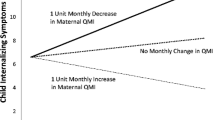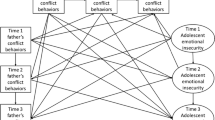Abstract
Parental hostility may have widespread effects across members of the family, whereby one parent’s hostility might disrupt the other parent’s ability to maintain a positive relationship with his or her children. The present study prospectively examined crossover effects of parental hostility on parent–child relationship quality in a sample of 210 families. At child ages 3, 4, and 5, mothers and fathers completed questionnaires assessing feelings of hostility. In addition, mother–child and father–child dyadic relationship quality were coded at each age during naturalistic home observations. Results from structural equation analyses indicated that mother and father hostility were relatively stable over the 2 years period. Further, results were consistent with notions of fathering vulnerability, such that the father–child relationship might be especially susceptible to parental hostility. Possible compensatory processes, wherein mothers may compensate for father hostility, were also explored. Child and parent gender add further complexity to the results, as the father–son relationship appears most susceptible to crossover effects of parental hostility, whereas the father–daughter relationship might be somewhat protected in the early childhood period. Findings from the current investigation highlight the need for broader perspectives on family functioning, considering influences across family subsystems and the effects of both parent and child gender.


Similar content being viewed by others
References
American Psychiatric Association. (2000). Diagnostic and statistical manual of mental disorders (4th Edn—text revision). Washington, DC: American Psychiatric Association.
Bayley, N. (1993). Bayley scales of infant development. San Antonio: Psychological Corporation.
Belsky, J., Crnic, K., & Gable, S. (1995). The determinants of coparenting in families with toddler boys: Spousal differences and daily hassles. Child Development, 66, 629–642.
Belsky, J., Youngblade, L., Rovine, M., & Volling, B. (1991). Patterns of marital change and parent–child interaction. Journal of Marriage and Family, 53, 487–498.
Bridewell, W. B., & Chang, E. C. (1997). Distinguishing between anxiety, depression, and hostility: Relations to anger-in, anger-out, and anger control. Personality and Individual Differences, 22, 587–590.
Brody, G. H., Pellegrini, A. D., & Sigel, I. E. (1986). Marital quality and mother–child and father–child interactions with school-aged children. Developmental Psychology, 22, 291–296.
Carrasco, M. A., Holgado, F. P., Rodríguez, M. A., & del Barrio, M. V. (2009). Concurrent and across-time relations between mother/father hostility and children’s aggression: A longitudinal study. Journal of Family Violence, 24, 213–220.
Chang, L., Schwartz, D., Dodge, K. A., & McBridge-Chang, C. (2003). Harsh parenting in relation to child emotion regulation and aggression. Journal of Family Psychology, 17, 598–606.
Chaplin, T. M., Cole, P. M., & Zahn-Waxler, C. (2005). Parental socialization of emotion expression: Gender differences and relations to child adjustment. Emotion, 5, 80–88.
Collins, W. A., & Russell, G. (1991). Mother–child and father–child relationships in middle childhood and adolescence: A developmental analysis. Developmental Review, 11, 99–136.
Cowan, P. A., Cowan, C. P., & Kerig, P. K. (1993). Mothers, fathers, sons, and daughters: Gender differences in family formation and parenting style. In P. A. Cowan (Ed.), Family, self, and society: Toward a new agenda for family research (pp. 165–195). Hillsdale, NJ: Lawrence Erlbaum Associates.
Cummings, E. M., & Davies, P. T. (2002). Effects of marital conflict on children: Recent advances and emerging themes in process-oriented research. Journal of Child Psychology and Psychiatry, 43, 31–63.
Cummings, E. M., Davies, P. T., & Simpson, K. S. (1994). Marital conflict, gender, and children’s appraisals and coping efficacy as mediators of child adjustment. Journal of Family Psychology, 8, 141–149.
Cummings, E. M., Merrilees, C. E., & George, M. W. (2010). Fathers, marriages, and families: Revisiting and updating the framework for fathering in family context. In M. E. Lamb (Ed.), The role of the father in child development (5th ed., pp. 154–176). Hoboken, NJ: Wiley.
Davies, P. T., & Lindsay, L. L. (2001). Does gender moderate the effects of marital conflict on children? In J. H. Grych & F. D. Fincham (Eds.), Interparental conflict and child development: Theory, research, and application (pp. 64–97). Cambridge, UK: Cambridge University Press.
Deffenbacher, J. L. (1992). Trait anger: Theory, findings, and implications. In C. D. Speilberger & J. N. Butcher (Eds.), Advances in personality assessment (Vol. 9, pp. 177–202). Hillsdale, NJ: Lawrence Erlbaum Associates.
Deffenbacher, J. L., Oetting, E. R., Thwaites, G. A., Lynch, R. S., Baker, D. A., Stark, R. S., et al. (1996). State-trait anger theory and the utility of the Trait Anger Scale. Journal of Counseling Psychology, 43, 131–148.
Derogatis, L. R. (1993). BSI Brief Symptom Inventory: Administration, scoring, and procedures manual. Minneapolis, MN: National Computer Systems.
Derogatis, L. R., & Cleary, P. A. (1977). Confirmation of the dimensional structure of the SCL‐90: A study in construct validation. Journal of Clinical Psychology, 33, 981–989.
Derogatis, L. R., & Melisaratos, N. (1983). The Brief Symptom Inventory: An introductory report. Psychological Medicine, 13, 595-605.
Downey, G., Purdie, V., & Schaffer-Neitz, R. (1999). Anger transmission from mother to child: A comparison of mothers in chronic pain and well mothers. Journal of Marriage and Family, 61, 62–73.
Enders, C. K., & Bandalos, D. L. (2001). The relative performance of full information maximum likelihood estimation for missing data in structural equation models. Structural Equation Modeling, 8, 430–457.
Erel, O., & Burman, B. (1995). Interrelatedness of marital relations and parent–child relations: A meta-analytic review. Psychological Bulletin, 118, 108–132.
Gerstein, E. D., Crnic, K. A., Blacher, J., & Baker, B. L. (2009). Resilience and the course of daily parenting stress in families of young children with intellectual disabilities. Journal of Intellectual Disabilities Research, 53, 981–997.
Gordis, E. B., Margolin, G., & John, R. S. (1997). Marital aggression, observed parental hostility, and child behavior during triadic family interaction. Journal of Family Psychology, 11, 76–89.
Harold, G. T., Fincham, F. D., Osborne, L. N., & Conger, R. D. (1997). Mom and dad are at it again: Adolescent perceptions of marital conflict and adolescent psychological distress. Developmental Psychology, 33, 333–350.
Hoffman, C., Crnic, K. A., & Baker, J. K. (2006). Maternal depression and parenting: Implications for children’s emergent emotion regulation and behavioral functioning. Parenting: Science and Practice, 6, 271–295.
Jacobvitz, D. B., & Bush, N. F. (1996). Reconstructions of family relationships: Parent–child alliances, personal distress, and self-esteem. Developmental Psychology, 32, 732–743.
Kerig, P. K., Cowan, P. A., & Cowan, C. P. (1993). Marital quality and gender differences in parent–child interaction. Developmental Psychology, 29, 931–939.
Kessler, R. C., McGonagle, K. A., Swartz, M., Blazer, D. G., & Nelson, C. B. (1993). Sex and depression in the National Comorbidity Survey I: Lifetime prevalence, chronicity and recurrence. Journal of Affective Disorders, 29, 85–96.
Kitzmann, K. M. (2000). Effects of marital conflict on subsequent triadic family interactions and parenting. Developmental Psychology, 36, 3–13.
Krishnakumar, A., & Buehler, C. (2000). Interparental conflict and parenting behaviors: A meta-analytic review. Family Relations, 49, 25–44.
Lamb, M. E., & Lewis, C. (2010). The development and significance of father–child relationships in two-parent families. In M. E. Lamb (Ed.), The role of the father in child development (5th ed., pp. 94–153). Hoboken, NJ: Wiley.
Larson, R. W., & Almeida, D. M. (1999). Emotional transmission in the daily lives of families: A new paradigm for studying family process. Journal of Marriage and Family, 61, 5–20.
Lovas, G. S. (2005). Gender and patterns of emotional availability in mother–toddler and father–toddler dyads. Infant Mental Health Journal, 26, 327–353.
MacKinnon, D. P. (2008). Introduction to statistical mediation analysis. New York, NY: Taylor and Francis Group.
MacKinnon, D. P., Lockwood, C. M., & Williams, J. M. (2004). Confidence limits for the indirect effect: Distribution of the product and resampling methods. Multivariate Behavioral Research, 39, 99–128.
Margolin, G., Christensen, A., & John, R. S. (1996). The continuance and spillover of everyday tensions in distressed and nondistressed families. Journal of Family Psychology, 10, 304–321.
Margolin, G., & Patterson, G. R. (1975). Differential consequences provided by mothers and fathers for their sons and daughters. Developmental Psychology, 11, 537–538.
McHale, J. P. (1995). Coparenting and triadic interactions during infancy: The roles of marital distress and child gender. Developmental Psychology, 31, 958–996.
Muthén, L. K., & Muthén, B. O. (2010). Mplus user’s guide (6th ed.). Los Angeles: Muthén & Muthén.
Newland, R. P., & Crnic, K. A. (2011). Mother–child affect and emotion socialization processes across the late preschool period: Predictions of emerging behaviour problems. Infant and Child Development, 20, 371–388.
Newton, T. L., Kiecolt-Glaser, J. K., Glaser, R., & Malarkey, W. B. (1995). Conflict and withdrawal during marital interaction: The roles of hostility and defensiveness. Personality and Social Psychology Bulletin, 21, 512–524.
Nolen-Hoeksma, S., & Rusting, C. L. (1999). Gender differences in well-being. In D. Kahneman, E. Diener, & N. Schwarz (Eds.), Well-being: The foundations of hedonic psychology (pp. 330–350). New York: Russell Sage Foundation.
Patterson, G. R. (1982). Coercive family process. Eugene, OR: Castilia Press.
Perry-Jenkins, M., Repetti, R. L., & Crouter, A. C. (2000). Work and family in the 1990s. Journal of Marriage and the Family, 62, 981–998.
Power, T. G., McGrath, M. P., Hughes, S. O., & Manire, S. H. (1994). Compliance and self-assertion: Young children’s responses to mothers versus fathers. Developmental Psychology, 30, 980–989.
Proulx, C. M., Buehler, C., & Helms, H. (2009). Moderators of the link between marital hostility and change in spouses’ depressive symptoms. Journal of Family Psychology, 23, 540–550.
Raley, S., & Bianchi, S. (2006). Sons, daughters, and family processes: Does gender of children matter? Annual Review of Sociology, 32, 401–412.
Rothbaum, F., & Weisz, J. R. (1994). Parental caregiving and child externalizing behavior in nonclinical samples: A meta-analysis. Psychological Bulletin, 116, 55–74.
Russell, A., & Saebel, J. (1997). Mother–son, mother–daughter, father–son, and father–daughter: Are they distinct relationships? Developmental Review, 17, 111–147.
Schermerhorn, A. C., Cummings, E. M., & Davies, P. T. (2008). Children’s representations of multiple family relationships: Organizational structure and development in early childhood. Journal of Family Psychology, 22, 89–101.
Simons, R. L., Whitbeck, L. B., Conger, R. D., & Chyi-In, W. (1991). Intergenerational transmission of harsh parenting. Developmental Psychology, 27, 159–171.
Smith, T. W., Sanders, J. D., & Alexander, J. F. (1990). What does the Cook and Medley Hostility Scale measure? Affect, behavior, and attributions in the marital context. Journal of Personality and Social Psychology, 58, 699–708.
Song, Z., Foo, M., & Uy, M. A. (2008). Mood spillover and crossover among dual-earner couples: A cell phone event sampling study. Journal of Applied Psychology, 93, 443–452.
Spielberger, C. D. (1988). State-Trait Anger Expression Inventory. Odessa: Psychological Assessment Resources.
Steinberg, L. D. (1981). Transitions in family relations at puberty. Developmental Psychology, 17, 833–840.
Stocker, C. M., Richmond, M. K., Low, S. M., Alexander, E. K., & Elias, N. M. (2003). Marital conflict and children’s adjustment: Parental hostility and children’s interpretations as mediators. Social Development, 12, 149–161.
Stormshak, E., Bierman, K., McMahon, R., & Lengua, L. (2000). Parenting practices and child disruptive behaviors problems in early elementary school. Journal of Clinical Child Psychology, 29, 17–29.
Stroud, C. B., Durbin, C. E., Wilson, S., & Mendelsohn, K. A. (2011). Spillover to triadic and dyadic systems in families with young children. Journal of Family Psychology, 25, 919–930.
Werner, N. E., & Silbereisen, R. K. (2003). Family relationship quality and contact with deviant peers as predictors of adolescent problem behaviors: The moderating role of gender. Journal of Adolescent Research, 18, 454–480.
Author information
Authors and Affiliations
Corresponding author
Rights and permissions
About this article
Cite this article
Newland, R.P., Ciciolla, L. & Crnic, K.A. Crossover Effects Among Parental Hostility and Parent–Child Relationships During the Preschool Period. J Child Fam Stud 24, 2107–2119 (2015). https://doi.org/10.1007/s10826-014-0012-7
Published:
Issue Date:
DOI: https://doi.org/10.1007/s10826-014-0012-7




